Adam Smith vs. the Visible Hand
Adam Smith, the father of Capitalism, wrote about “The Invisible Hand”. The Invisible Hand is the functioning of a capitalist system, which would always bring good. Adam Smith imagined a well honed system of free markets plus enveloping democracy that turned people’s innate greed into productivity. I like the idea that some people are hungry and hire me to make their dinner and both parties benefit. But what if there is only a finite amount of food to be turned into dinner? In a reality of limited resources, the blind Invisible Hand hits a wall.
Jonathan Swift satirized this exact scenario in his writing on the Irish Potato Famine. The most shocking part of that actual historical event is that the Irish continued to export food while their population was dropping dead from famine! The “Visible Hand” is what is inevitably called in to clean up after the fervent workings of the Invisible Hand are complete. In the case of the Irish, the grave diggers together formed the thumb of the Visible Hand.
In the case of Onondaga Lake in Syracuse, NY, which was turned from a resort lake to the worlds dirtiest waste pit in the span of a 100 years, the Visible Hand takes the form of giant cranes currently dredging the lake. Honeywell’s externalities are largely to blame for the continuing mess, though the lake has indeed gotten a lot better. Nonetheless, the tons of mercury persist: 22 pounds of it was dumped per day at the nadir of industrial lake use. Corporations externalize risk by externalizing as many costs as possible. This is great for the share holders in the short term, but awful for the other stake holders (the community, the environment) in the long term. The externalities disappear off the record books and reappear smack dab in the middle of our lives.
Remember the time before the 2008 crash? The “Trickle Down” theory seemed somehow semi-real, at least in the form of that slightly bitter drip in your throat after the party at your financier’s friend’s Manhattan apartment. Today, as the economy sinks, corporations are evaporating way faster than the festering pools of externalities they leave behind. The Visible Hand is made of the thousands of Chinese people hired to paint pollen onto flowers to polinate them, filling in for the deceased bees. The Visible Hand is the conglomeration of crews and communities cleaning up and dealing with catastrophic oil shipping accidents that could have been prevented (Exxon Valdez Spill: captain was drunk). The Visible Hand are the people lighting their tap water on fire after they’ve signed their land over to Hydraulic Fracturing (‘Fracking’) projects.
In a Russian fairy tale from my childhood there is a whale so large that a whole city exists on it’s back. I am fascinated with the idea that the whale can do it’s thing and due to it’s sheer size never even feel the city. At the same time, the citizens of the city are going about their business, not even noticing that they are living on a whale! I haven’t seen such a beast as that whale in real life until I saw the bucket excavator. Is that thing really real‽ It looks like Dick Cheney’s steam punk fantasy nightmare. And if you look at it, there is even a little house on it! It looks like a fine family home, but how long can someone live up there? And why do they need to live on the excavator anyway?
Perhaps the bucket excavator is also a whale, swimmingly guided by that ever-determined Invisible Hand, mining dirty brown coal for us to burn for electricity. I don’t want to think about the kind of Visible Hand we are going to need to arm wrestle this bad boy. The bucket excavator symbolizes the mutability of the Invisible Hand, it’s slow but crushing fatalistic lexicon. But the bucket excavator is easy to pick on you might say, and other examples of apocalyptic machinations of State Captialism are probably more salient.
Take for example, the trucks Bloomberg just unleashed on the Occupy Wall Street protesters. The amazing sound weapons were used to bring the protesters to their knees do the bidding of the Invisible Hand, which by this point carries signs of gangrenous infections of government corruption. The fetid smell of a wormed-through congress, pampered by lobbyists and drunk on insider information, has swirled around the fingers of Adam Smith’s Invisible Hand. As we sit by and feel the Invisible Hand fisting our future, we may ask: is so-called “progress” evil?
Progress is great, and anyone who says that in order to stay competitive we have to steer clear of environmental regulations is probably someone who is not willing to face the true costs. People say that wind and solar energy would be competitive with coal if the price of coal reflected it’s true cost. Recent reports show that despite the economic downturn, CO2 production kicked up 5% in 2010. Global subsidies for the fossil fuel industry is being approximated at the astronomical levels of 400 billion. Yet, in the US the energy companies invest only 2% on R&D (as written about in a recent New Yorker magazine issue). Basically, that is almost nothing. We need uncorrupted regulation to wrap the uncorrupted free market and achieve a system that makes sense.
The current condition of Corporatism, or Statism, is fragile. The system claims to be doing it’s best: and like HAL 9000 it is apocalyptically wrong. The Invisible Hand, though it is festering with infected abscesses from bailout injections and bedraggled with engorged ticks of greed is flailing forward and shaping and re-shaping the world in it’s image. But the Visible Hand knows what the other hand is doing. The Visible Hand is inevitable. The Visible Hand will HAVE to do the clean up.
LMNOPF Presents: Madlib, Kid Koala, Back From Japan, and Prefuse73
A celebration of EMPAC’s opening with video drums.
EMPAC’s Opening Gala after-party in October 2008 was headlined by the legendary musician and producer Madlib. The ever-innovative VJ collective Vidvox was asked to take advantage of the one-of-a-kind cylindrical screen hanging over the stage and asked me to join them. I played the electronic drum instrument we created for the event that controlled custom video synthesizers. Â We began rehearsing and realized we could be a Live Video (VJ) band which led to performances under the name LMNOPF Presents.
For the Kid Koala show at Revolution Hall in Troy New York we rigged up a butcher paper screen over the dance floor. We projected mashed up websites, text, and live digital painting with video synthesizers powered by our VJ electronic drum set. The drum set was actually just a drum controller from the video game Rock Band that we piped into the VDMX software.
We were excited to VJ for Dan Deacon but at the last moment Dan got hurt and couldn’t come. Â In the end Prefuse73 came instead, and I was already a fan after having seen Prefuse in Brooklyn a few years back. Â I was excited to bust some video drum groovers for this noble purpose. Â The show was great all around and we shared the bill with Skeleton$ and Luciano Chessa. Â Skeleton$ showed us their crazy vintage electric guitars which had super ancient shitty pickups paradoxically getting louder (though noisier) as they degraded giving the band all sorts of microtonal range. Â Luciano Chessa did a fantastic rendition of Marinetti’s Futurist sound poem Zang Tumb Tumb. Â I’ve known about this poem for years but have never heard it read by an Italian live, especially one with such theatrical fervor. Â Below are some stills from our video show that night.
Throughout this time we were backing DJs such as Back From Japan and even playing holiday parties.  Another highlight was VJing a music performance battle by Disposable Rocket Band and My Robot Friend which I curated and for which we created a video performance called Citizen Burger.  We mined video from the Nintendo game Burger Time as well as video of David Lublin walking around and eating many different hamburgers from several restaurants while wearing a specially designed POV camera harness. Below is the flyer I created for the event.
Video Drumming at EMPAC in Troy, NY
It was almost three years to the day that the Experimental Media Performing Arts Center opened in Troy, NY. EMPAC is one of the reasons I miss living in Troy. It’s an interesting venue that brings artists, performances, and installations into Troy and ends up pulling an audience in from surrounding cities. Back then I was part of LMNOPF, a multi-media performance troupe. My role was that of the video drummer.
I banged on a drum-kit from the video game Rock Band and the MIDI events triggered a video synthesizer made by David Lublin. This was the setup we used to back JUICEBOXXX when he opened for Madlib and J.Rocc. Checkout a good summary video of the night by Sebastien B. JUICEBOXXX had an 8-bit sound going for some of his backing tracks, so the video synthesizer relied on a disco color-scheme. Every hit of a pad revealed a new color bar, while the kick-drum advanced the color sequence to the next one. The amount of color bars on the screen increased as the performance went on. This straight-forward setup was perfect for JUICEBOXXX who was hot and bothered and running around on the floor with the kids. Here is a newly acquired video of a track and a half.
Adding Android support to WP_Slider WordPress theme
I am helping a friend out with a website. He wants to have a wordpress theme with a media content slider and he wants it to work on smart phones. I found that the two best sliders that handled images and video (AnythingSlider and WP_Slider Theme) had a bug when viewed on my Android HTC Incredible (Android 2.2, WebKit 3.1 Browser). I found that the bug is on the Android browser side, and created this quick and dirty patch of WP_Slider Theme to work on Android.
There seems to be a bug in Android phone browsers relating to overflow:hidden CSS property. The overflow property, when set to hidden on a div causes any elements that spill out of that div’s bounding box to be clipped and not shown. It seems that on my phone’s browser this breaks for videos. Youtube embeds, for example, float on top of everything even when they are supposed to be hidden.
Using jQuery and CSS selectors I found all the elements that are supposed to be hidden and set their visibility to hidden as well, which really hid them even on my phone. Here is the diff to WP_Slider Theme (generated with git) that shows my changes. I’m also including another patch which hides redundant commenting links in the theme. More specifically, the theme doesn’t differentiate between a first-time reply (first comment ever) link and a link to previously made comments. Other than that it is a fine theme, though if I end up using it I would tone down the graphics quite a bit.
SoYummy Lecture Performance at McGill
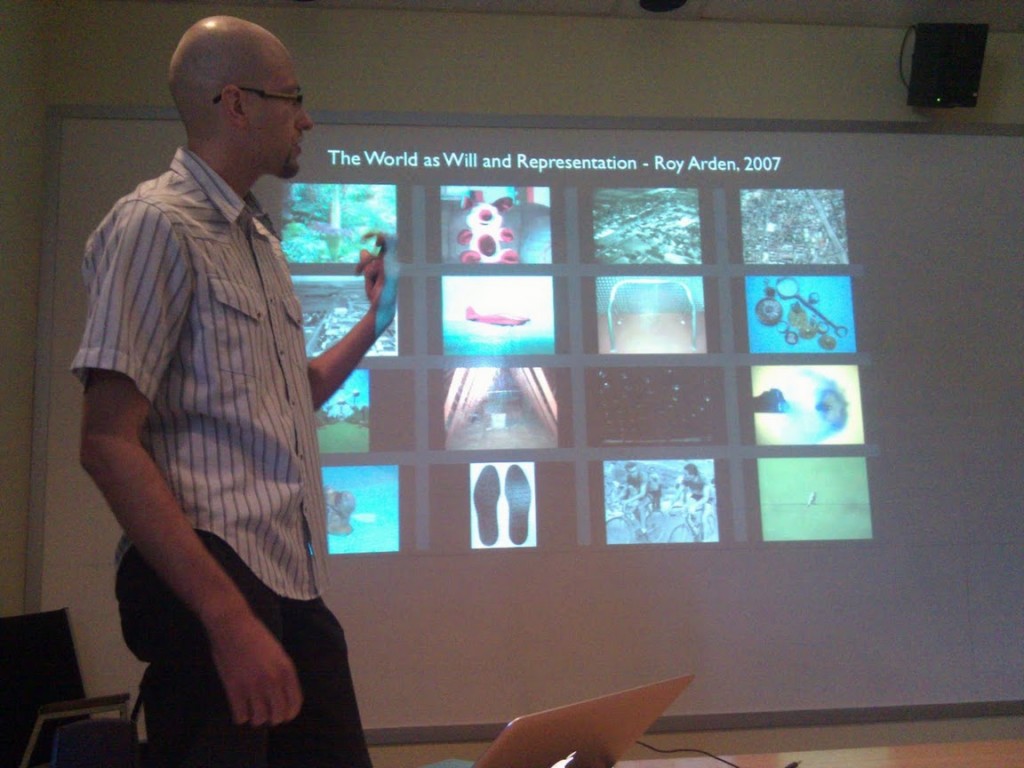
Misha Rabinovich giving the SoYummy lecture performance and showing Roy Arden's The World as Will and Representation SoYummy summary. Photo by Yogesh Girdhar.
On Wednesday, August 3rd, I gave a lecture performance at the robotics building on the McGill campus in Montreal. There was a good audience — both in terms of numbers, energy, and inquisitiveness. I presented research and ideas stemming from my experimentation with computer vision software being developed at McGill. A good amount of the audience was already familiar with the research behind the software, so I had the pleasure of presenting ideas from new perspectives of art theory and philosophy.
According to Charlie Hoban (Educational Technology theorist), the lecture as performance is achievable by only 2% of lecturers and is worth digitizing for the future. Even though the bandwidth limitations for disseminating such lectures he describes will soon seem laughable, I agree that the question of bandwidth is central to this subject. Lecture as performance is an effective information dissemination vehicle because it is so high bandwidth: it combines the visual, aural, gestural, and sometimes tactile and even olfactory senses.
Last year’s curatorial inquiry on the subject at the Museum of Contemporary Art in Belgrade asks “is contemporary art a product of fascination with aesthetic objects or a space of knowledge production?” The most successful art created these days falls into the latter category. It is art that engages the audience in confronting real changes happing in the current world. Contextual Art, as described by Jan Swidzinsky is a particularly attractive approach when presenting to a scientifically minded audience because Contextual Art accepts both art and science as disciplines capable of responding the rapid changes of our technologically accelerated world. From this angle, Lecture as Performance is a post-modern practice because of its emphasis on the communication of information through the melding of pedagogic as well as theatrical approaches (and sits in opposition to Modern Art as art for art’s sake).
Joseph Beuys, who is one of the originators of the Lecture as Performance form (stemming from his ‘Social Sculptures’) wrote that “The most important discussion is epistemological in characterâ€. This is especially true now in our economy of abundance where there is more media being produced than anyone can possibly consume. When the information about our world comes to us in such a fragmented state, from so many different ‘news’ outlets, and filtered by so many layers of special interests, its hard to know what is true and what is bent. Epistemology helps us answer how we know what we know, and Lecture as Performance is an artistic approach to investigating these questions.
Walt Whitman, late in life, lamented that he didn’t tour and read his poetry to the masses to increase his audience. Plenty of examples of artists and scientists disseminating ideas through Lecture as Performance hang in our collective memory. From Tesla’s highly influential demonstrations of radio to Nabokov’s lecture tours through the United States to Laurie Santos’s insightful TED talk on the “monkey economy” and human irrationality we learn of key ideas right from the horse’s mouth. Despite the continuously increasing complexity of the world around us, the old adage of ‘if you can explain it to a 4 year old, you really understand it’ is more true than ever. Lecture as Performance is that ultra-high bandwidth communication channel on which the most relevant truths of today can set sail, powered by nothing more than a person’s breath.
Through the combination of my creative practice and access to the latest cv research (in the form of Yogesh Girdhar’s software) I am able to devise artistic experiments and achieve insight. Through creative application of this research to solve the problems of our economy of abundance we can open new engagements between Art and Science. The impact of Temporal Semantic Compression on Culture will be determined with time and experimenation, and I’m excited to bring the latest insights to interested audiences. The poetic engagements with Art History and Philosophy are more illuminating to the scientific crowd, while explaining the science behind the software is more enlightening to the art audience. The presentation remains accessible for even the most general audience, who is often interested in these subjects and the impact of new technology on their life.
The lecture performance at McGill went really well and I would like to thank Yogesh Girdhar and Gregory Dudek once again for inviting me there. One excellent criticism of the talk was that I didn’t take the opportunity to delve into Lecture as Performance itself: I stayed in character during the question/answer session and didn’t step up to the meta-level. From the Lecture as Performances that I’ve seen personally, it doesn’t seem common for the performer to break out of character during the lecture or even the question/answer portion (if there even is one). One reason this is unclear to me is because the lecture performance itself is not an act: it is honest expression of subjective and objective truths. Thanks to everyone for coming out and being part of the event and I look forward to the next one.
SoYummy hits Subtle Technologies 2011
I just caught up on the sleep I missed during this year’s Subtle Technologies conference in Toronto where Yogesh Girdhar and I did a poster presentation on the SoYummy project. I wanted to do a post about the conference, who I met there, and thoughts on going forward.
The third annual Subtle Technologies festival/conference continued in the Art+Science vein of the previous years. There wasn’t a specific theme this year, but the talks and posters were well enough related to provide a consistent experience. Just because the conference was Art oriented doesn’t mean that all the talks were exciting though. Australian artist Mary Rosengren’s presentation about her collaboration with scientists was too general and at times aggravating while refusing to resolve into a coherent idea at the end. Robyn Moody—who creates fascinating kinetic sculptures related to relevant social topics—was unable to speak about the work in a cohesive way when he wasted 10 whole minutes on an unrelated introduction about the woes of vaccine paranoia.
I experienced several stellar presentations. I wasn’t able to catch all of them, but the scientists Ben Schumacher of Kenyon College and the zany Stephen Morris gave illuminating and engaging talks ranging from the consequences of Eistein’s relativity to patterns in nature. The vibrant Ben Schumacher explained how traveling faster than the speed of light would also mean traveling back in time. Stephen Morris showed how the fascinating formation called The Giant’s Causeway in Ireland was formed and how the same uniform cracking can be repeated at home.
Impassioned presentations by Italian curator Marco Mancuso illuminated larger connections between scientific and artistic research. Two dance related presentations by artists and choreographers Gail Lotenberg and Carl Flink showed innovative collaborations with scientists which resulted in beautiful dance performances captured on video. Jenny Leary’s nuanced advances in magnetic craft techniques traced the trajectory of an artist/inventor.
While some presenters strategically left out specifics, a few did so to their detriment. Riccardo Castagna and Valentina Margaria gave a concise and engaging presentation about their multi-modal Biomatics Virus. The idea itself seemed a bit of a rehash of the Neil Stephenson novel Snowcrash. The music that they generated from a 3D model of the H1N1 virus sounded great though. However, when asked by the audience about their process for converting virus structure data to make the music sound nice, they answered that they did nothing to smooth the raw data, further obscuring the connections between their science and art. Alan Majer’s (of Goodrobot.com) presentation on the other hand was strategically vague in order to open up room for the imagination: how would our society change if we could physically connect our brains together?
Yogesh Girdhar (aka Yogi) and I got a lot of attention with our poster, especially because we ran a demo of the latest software on a laptop. The software uses open source computer vision libraries to quantify the video coming in. It then uses Yogi’s unique qualification algorithm to decide how surprising an incoming video frame is (compared to what was already seen). If the input is surprising, the still is added into the summary of 9 images. We presented the demo as a contest to excite people to try to surprise the computer and make in into the summary. This was mega fun, and here is the resulting summary of the winners:
Socially I was lucky to meet and hang out with some amazing artists. Ted Hiebert, an artist and educator from University of Washington Bothell, blew our minds with his “plausible impossibilities” and descriptions of his telekinesis contests. Doug Jarvis, an artist-in-residence fellow at the Center for Studies in Religion and Society at University of Victoria BC, described the implications of brain cells in our gastrointestinal tract. I was psyched to meet a key member of the Yes Men: the artist and animator Patrick Lichty. Patrick is creative and generous artist and educator and is now working with Second Life and on cloning William S. Burroughs from a preserved turd. I also enjoyed conversations with Cara-Ann Simpson, Gail Kenning, Eva Kekou, Daryn Bond, Willie LeMaitre, and ginger coons (who gave me a copy of her amazing magazine produced using only free and open source software) among others. The social dynamics culminated with dancing at the party thrown by conference organizer and Director of Programs Jim Ruxton where we set up yet another Surprise Contest. Here is the summary images of the winners:
In conclusion I would like to thank Jennifer Dodd for helping with the logistics and poster curator Lorena Salome for the vital help with the poster. Thanks to Subtle Technologies for having us there. It seems that the talking presentation slots were reserved for those people who’ve taken their project into the world and have documentation of the interactions with other people. I would like to get our project to that level and do a presentation at Subtle Tech next year.
Why did Foursquare delete my account‽
My Solace 2.0 project encountered some interesting snags. First, Bird Library employees pulled and threw away my brochures. When I was first figuring out the brochure design I kept thinking about how the installation had to conform to the library venue in unique ways. For example, due to a history of artwork theft, the installation had to be ensconced in the heavy wooden case. This limitation turned into a benefit when the case proved to have just enough space for the work. I thought that since the library is informing and encroaching on my artwork in an interesting way, I should reflect this reality and creatively encroach on the library—just to smooth out the borders between the art and the library.
The library brochure, called “Research Helper” is actually a well designed note-taking booklet with lots of blank pages inside. I decided to write my artist statement on the blank slate pages of the library Research Helper brochure. But this proved tedious, so I decided to scan the brochure, add my text, and print out copies. I modified the design and added more icons and information, while keeping the original design credit and the library logo. This worked well for about three weeks, after which the library became concerned about their logo used in such an unofficial way. What they did was not censorship per se, but a legally motivated action that I can’t really argue with. In place of my brochure, Ann Skiold printed out the library’s blog post about the installation and stuck copies in the brochure holder, which was a positive gesture.
This was not the only snag, however. I noticed after about a month of running Solace 2.0 at the library that new points were not being created, while the old points were still being pruned normally. The face was starting to thin out and disappear. It appears that Foursquare didn’t like something about the project, and deleted my account without warning. I read all the terms and policies before I did the project, and wasn’t breaking any rules. I kept my API use below the request frequency limit and didn’t create multiple accounts. We will see what they say.
Email to Foursquare:
“Hello,
I noticed about a month ago that my Foursquare account was deleted without warning. I wasn’t breaking any of the terms of use, and was using the API within the API frequency use limit. I am an artist, and I am using Foursquare for an art project. Here is a brief description of the project. The second blog post down is an artist statement.
https://misharabinovich.com/blog/?cat=18
I was wondering why my account was deleted. I wasn’t doing anything illegal. I’m getting ready to release detailed documentation about the project and my findings. I think you would be interested in what I discovered. However, I wanted to find out what happened with my account before I did so. My user id was 3283208
Any information would be greatly appreciated!
Misha Rabinovich”
Solace 2.0: A Performance in Radiation installation is up!
Syracuse University’s libraries have extensive archives or both common and rare media. Their collection just got that much more unique with the inclusion of Solace 2.0: A Performance in Radiation, an installation/performance by yours truly Misha Rabinovich. The project deals with making one’s mark on the world, manifest destiny, surveillance, and social networks.
This project is an installation because of its transmedia form encompassing books, movies, pictures, and video. The installation includes a computer which is hosting and running the Solace 2.0 Social Media Platform. This platform automatically engages social networks so the user (currently just myself) can sit back and focus on other things. The project is also a performance because the identity of the user is split up through the engagement with the platform into a separate online entity that travels on its own.
The installation features several images representing various attempts by different entities to “make a name for themselves” and to be “masters of their domain” ranging from the monumental and permanent to the feeble and ephemeral. Among these images stands a computer monitor, framed in glossy black and gothic red. The monitor shows a grey map with red map markers specifically placed to outline the face of the user. As the points disappear and reappear over time the face exhibits a shimmering quality.
The points represent locations of actual real world venues (restaurants, businesses, etc) which have been registered in a geolocation game called Foursquare. To play such geolocation games, people ‘check in’ to locations they are currently at using their GPS enabled phone. Solace 2.0 checks the user into locations automatically, without the user having to go anywhere. It also publishes the checked-in locations on Twitter.
Everyone is encouraged to visit and experience the installation firsthand at the Bird Library and to pick up a free brochure. Please stay tuned for more information and updates on this project (you can even grab the RSS feed for your reader here). Thank you to Ann Skiold for opening the library for this work. Thanks to Holly Rodricks for proof reading and Caitlin Foley for exhibition consultation and general support. Thank you to Megan Foley for sponsoring this installation. Thank you to Matthew Williamson for pointing out how this falls in with “Griefing” (I will be writing about this soon).
Solace 2.0 Statement

The ideal face points are picked and targeted. Solace then checks into Foursquare venues nearest to the targets.
To make a name for oneself, to be master of one’s domain, and to leave one’s mark on the map are goals shared by many. Solace 2.0 establishes and maintains one’s identity in today’s Internet-enabled economy of attention while preserving the user’s personal integrity. And it does it automatically, so the user can sit back and concentrate on what’s important.
Social networks seek to conform individual identities into their molds in order to monetize people. The fundamental bargain presented to users of Internet-based social networks is: if you publish private information about yourself, you will reap social rewards. Those who seek attention as capital accept this bargain. But the requirement to conform one’s identity into a social network’s profile is a farce. The Internet—with its ability to robustly connect people across great distance—doesn’t reflect our physical existence but copies, fractures, and multiplies our individual identities. The Internet’s commercial power necessitates the compression of our identities into tokens of trust so that we can buy and sell. These tokens of trust are examples of our newfound disembodied, autonomous, and powerful telekinesis. Our actions online persist in time, creating our data body, which is also a shadow sometimes appearing to dance of its own volition. Each of us is in many places at once.
“Griefing†means harassing online communities (often anonymously) to remind them not to take themselves too seriously. “Griefing†can result in online communities feeling grief. The opposite of grief is solace. “Griefers†feel solace when doing the Griefing and solace supplants grief when one is consoled or relieved.
The Solace 2.0 platform checks you in and keeps your persona fresh.
Human Amusement Videos From the Basement
Meyer Giordano is a hacker with strong alchemical leanings. He showed me around his laboratory at the Warehouse which featured a massive frustrated internal reflection interface slicked with vaseline (to increase reflectivity). In the following clip, Meyer demonstrates wireless power transmission through some kind of plasma fire. When he draws the receiving node (screwdriver) close enough, the tens of thousands of volts leap to it. That lights up the LEDs.
In this clip, we see what melting a screw driver can deliver. I smelled that metal vaporizing.


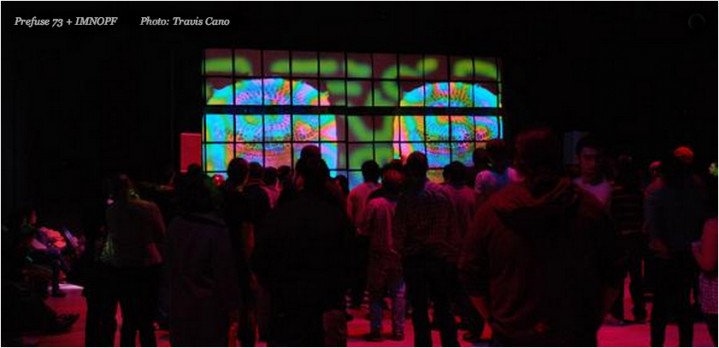

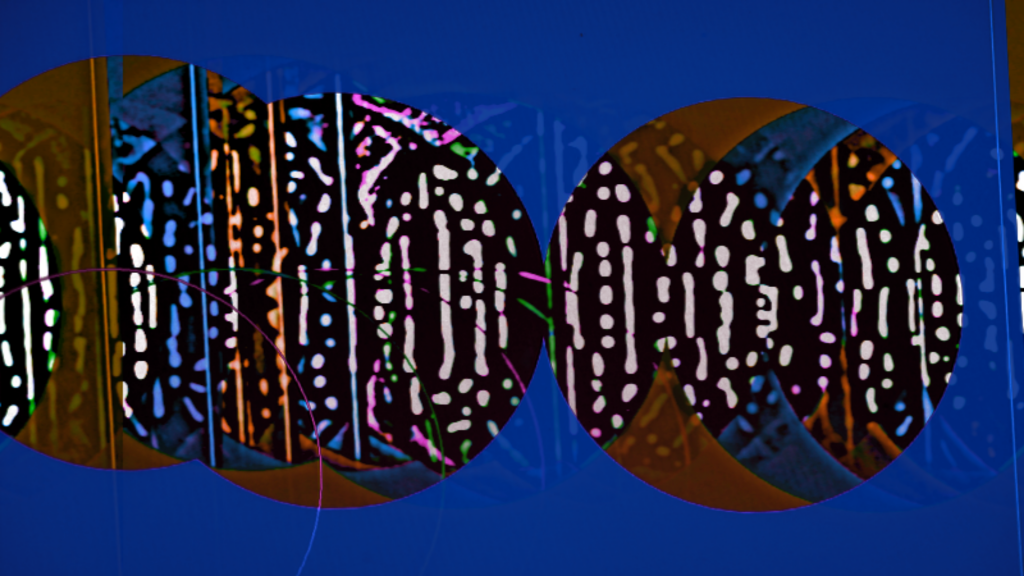
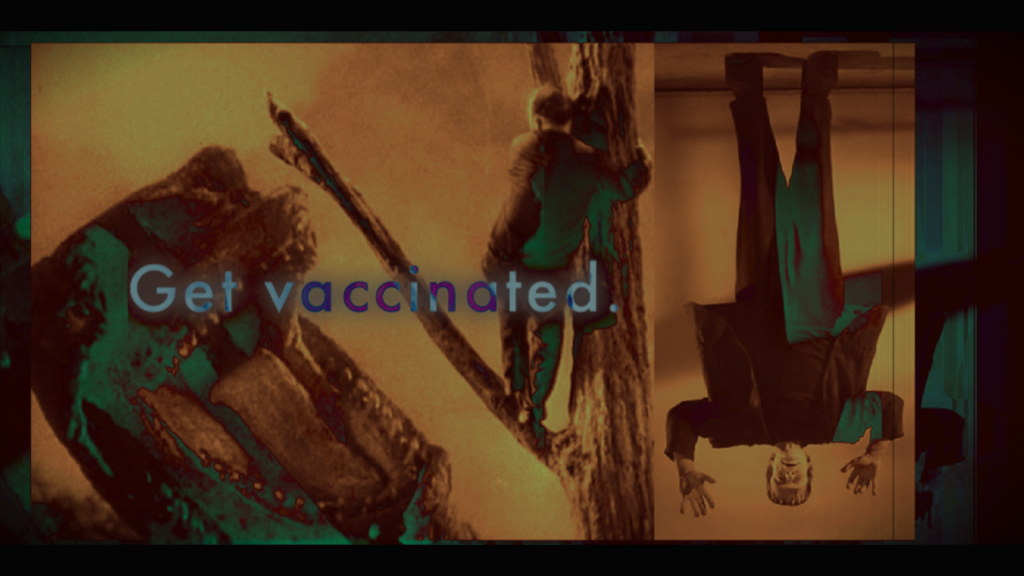
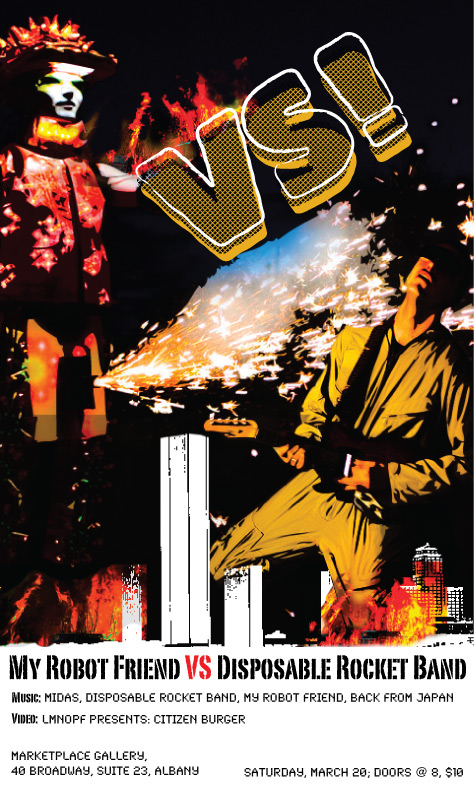


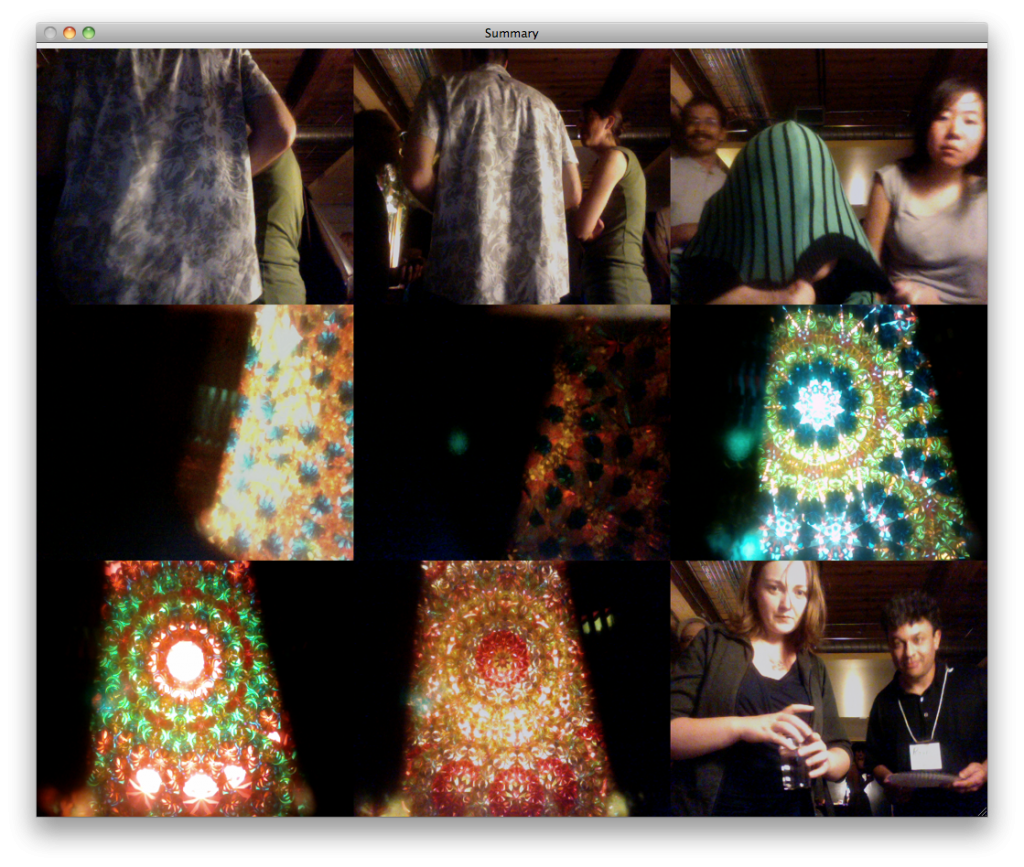
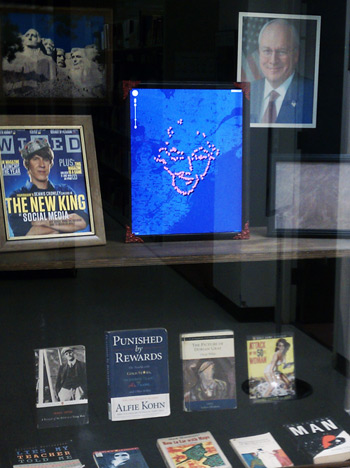
leave a comment